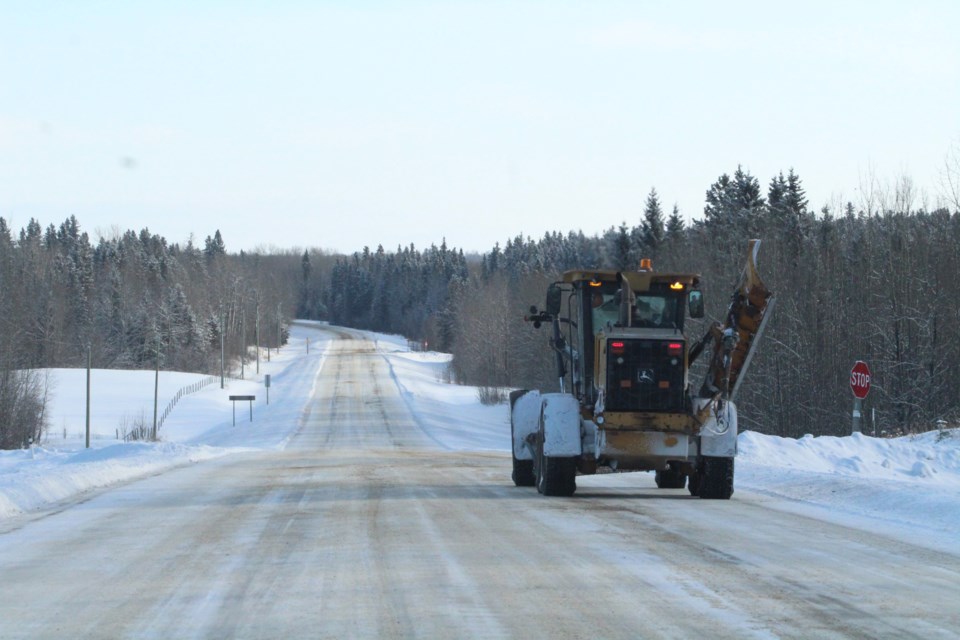We might be in the heat of summer, but that doesn’t freeze the chance for Lac La Biche County councillors to discuss winter issues that can be hot-button issues.
Lac Lac Biche County’s current Snow Removal and Ice Control Policy has not been updated since 2014. Municipal administrators now say the current policy is too vague and does not provide adequate metrics for when snow should be plowed and removed. They want to be ready to act accordingly when the snow flies.
“Quite frankly, it's easier to deal with this now when you're not in “the heat of battle” with the snow,” said Ken Van Buul the CAO for Lac La Biche County.
So, as summer begins, the administration is using this time to rethink the existing policy and find suitable revisions that take into account costs, as well as the needs of business owners and residents with the intention that a more specific policy be drafted and finalized before the snow hits the ground.
“At times, the lack of proper service levels has made it more difficult to deal with the public’s or even Council’s perception on when to trigger a snow pickup,” reads a statement provided by County administration, who rely the policy to make snow removal decisions.
Ongoing concerns
The municipality’s current procedure is to flatten smaller snowfall amounts, allowing for snow to be packed down until it accumulates enough to reach an outlined “trigger point.” When this point is reached, it is then plowed and hauled off-site. In the Plamondon and Lac La Biche downtown core, this trigger point is set at 10 cm of “hard pack” snow and is similarly set at 15 cm for residential areas.
However, the policy does not have a mandated trigger point for single snowfall events that see large volumes of precipitation. Even if a snowfall exceeds 15cm from a weather event, there may be no immediate response from the County’s snow removal crews because it may not meet the required standard of “hard pack” accumulation. This is something policy makers would like to see changed.
Additional clauses likely to be added to a revised policy include clear timelines around when snow will be removed and the inclusion of trigger points for single major events that exceed 15 cm of snowfall in both commercial and residential districts.
Although, administration warns that cost could play a limiting factor. A snowstorm that swept through the region for a period of two days in January, left the municipality with a bill of approximately $127,000 to clear and relocate snow from the County’s roadways. The hauling of the snow cost two-thirds of that overall price tag, said the county’s public works boss Brian Shapka, putting the transportation costs at more than $88,000.
“Something to keep in mind when we are setting standards is that there is a monetary issue to it as well,” said Shapka, the associate CAO for Infrastructure Services. “We have to make sure that we have a sufficient budget now that we're going to be chasing snowflakes - so to speak - our expectations have to be reasonable.”
Councils' suggestions
Some of the suggestions from councillors to improve the policy and manage costs included using additional metrics for determining when snow is eligible for plowing and removal, such as increased temperatures to remove snow slush, improving monitoring of all areas within the region that may be experiencing different weather patterns and potentially adding a “bare pavement policy,” which could see snow removed down to the road surfaces at regular intervals rather than waiting for packed snow to reach trigger points.
‘Reset’ the snow
Councillor Lorin Tkachuk says a concern he sees is when accumulation thresholds are not reached, leaving ice and slush, inconveniencing residents and business owners. He suggested that the “bare pavement” practice could be used to improve snow removal services.
“It doesn't necessarily mean that the pavement’s bare at all times, but it means that it's brought down to bare pavement at certain regular intervals — so there is that reset,” he says.
Rural areas that can see portions of roads blanketed in layers of snow even without a recent snowfall was also a hot issue for councillors wishing to see a faster response of snow removal and closer monitoring of snow obstructions.
Most grader operators stationed in rural areas have about 100 kilometres of roads to clear on their routes, said Shapka. Even with average conditions, that can mean a route could take up to three days to complete. For residents at the opposite side of the route, snow removal can be a longer wait than most would prefer.
When you combine that with drifting snow and less traffic to pack down new accumulations, the problems for rural residents just snowballs, says Owl River-area councillor Sterling Johnson.
“We have totally different conditions compared to town,” he said. “In some areas you might have seven or eight inches of snow and drifting snow with the winds. And then you have lots of people stranded that can't get out or have a hard time getting around.”
The current policy allows for five days to lapse after the end of a snow event before crews are required to clear rural arterial, collector and other local roads.
“If it finishes snowing on a Saturday, it sure would be nice to get those people working in their jobs in town on Monday, but we're not going to get them there if the graders aren't out there on the weekend,” Johnson added.
The discussions are the first part of the ongoing process to upgrade the policy. More changes and discussions are expected to be heard in the coming months.
A Screen grab image from the Lac La Biche County presentation of all roads cleared by the municipality, which crews clear once accumulated packed snow reaches specific ”trigger points” based on location and designation of the road.


